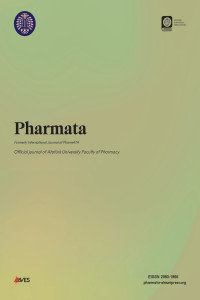Gut Microbiota and Its Importance for Our Health
Gut Microbiota and Its Importance for Our Health
In 450 BC, Hipocrates stated, “All diseases begin in the gut. When the gut is sick, the back part of the body is also sick.” This sentence is explained with the term “microbiota” in human body. Microbiota is the environment where microorganisms such as fungi, bacteria, and virus live together in our body. These microorganisms are found in certain parts of our body, upper respiratory tract, gastrointestinal tract, urinary system, eyes, and skin. Microbiota has been shown to change according to drug use, nutrition, age, and environment. As a result of these changes, learning, memory, functioning of the psychological or immune system, drug metabolism, and hormonal changes may occur. The aim of this article is to explain the importance of intestinal microbiota which is our second brain and the importance of our health.
Keywords:
Intestinal flora microbiota, microorganism,
___
- 1. Kaplan NTC, Milli Eğitim Bakanlığı Gıda Teknolojisi Gıda- Mikroorganizmaİlişkisi. Ankara; 2015:4.
- 2. Zhu X, Han Y, Du J, Liu R, Jin K, Yi W. Microbiota-gut-brain axis and the central nervous system. Oncotarget. 2017;8(32):53829-53838. [CrossRef]
- 3. Eckburg PB, Bik EM, Bernstein CN, et al. Diversity of the human intestinal microbial flora. Science. 2005;308(5728):1635-1638. [CrossRef]
- 4. Yılmaz K, Altundiş M. Gastrointestinal microbiota and fecal transplantation. Nobel Med. 2017;13(1):9-15.
- 5. Xu Z, Knight R. Dietary effects on human gut microbiome diversity. Br J Nutr. 2015;113(1)(suppl):S1-S5. [CrossRef]
- 6. Yatsunenko T, Rey FE, Manary MJ, et al. Human gut microbiome viewed across age and geography. Nature. 2012;486(7402):222-227. [CrossRef]
- 7. David LA, Maurice CF, Carmody RN, et al. Diet rapidly and reproducibly alters the human gut microbiome. Nature. 2014;505(7484):559- 563. [CrossRef]
- 8. O'Mahony SM, Felice VD, Nally K, et al. Disturbance of the gut microbiota in early-life selectively affects visceral pain in adulthood without impacting cognitive or anxiety-related behaviors in male rats. Neuroscience. 2014;277:885-901. [CrossRef]
- 9. Chow J, Lee SM, Shen Y, Khosravi A, Mazmanian SK, Host–bacterial symbiosis in health and disease. Adv Immunol. 2010;107:243-274. [CrossRef]
- 10. McFall-Ngai M, Hadfield MG, Bosch TCG, et al. Animals in a bacterial world a new imperative fort he life scienes. Proc Natl Acad Sci USA. 2013;110(9):3229-3236. [CrossRef]
- 11. Whitman WB, Coleman DC, Wiebe WJ. Prokaryotes: the unseen majority. Proc Natl Acad Sci USA. 1998;95(12):6578-6583. [CrossRef]
- 12. Arweiler NB, Netuschil L. The oral microbiota. In: Schwiertz A, ed. Microbiota of the Human Body. Switzerland: Springer; 2016:45-60. [CrossRef]
- 13. Grice EA, Kong HH, Conlan S, et al. Topographical and temporal diversity of the human skin microbiome. Science. 2009;324(5931):1190-1192. [CrossRef]
- 14. Pappas S. Your Body Is a Wonderland of Bacteria. Science NOW. American Association for the Advancement of Science; 2009. Available at: https ://ww w.sci ence. org/a ction /doSe arch? AllFi eld=y our+body+i s. Accessed June 22, 2023.
- 15. Cogen AL, Nizet V, Gallo RL. Skin microbiota: a source of disease or defence? Br J Dermatol. 2008;158(3):442-455. [CrossRef]
- 16. Borges S, Silva J, Teixeira P. The role of lactobacilli and probiotics in maintaining vaginal health. Arch Gynecol Obstet. 2014;289(3):479- 489. [CrossRef]
- 17. Joklik WK, Willett HP, Amos DB. Zinsser’s microbiology. In: David T., et al., eds. Toledo, OH: Apple ton-C entur y-Cro fts, Inc; 1976:404.
- 18. Rosenwald AG, Arora GS, Madupu R, Roecklein-Canfield J, Russell JS. The human microbiome project: an opportunity to engage undergraduates in research. Procedia Comput Sci. 2012;9:540-549. [CrossRef]
- 19. McFall-Ngai M. Adaptive immunity: Care for the community. Nature. 2007;445(7124):153. [CrossRef]
- 20. Bianconi E, Piovesan A, Facchin F, et al. An estimation of the number of cells in the human body. Ann Hum Biol. 2013;40(6):463-471. [CrossRef]
- 21. Biedermann L, Rogler G. The intestinal microbiota: its role in health and disease. Eur J Pediatr. 2015;174(2):151-167. [CrossRef]
- 22. Nardone DA. Collecting and analyzing data: doing and thinking. In:Walker HK, Hall WD, Hurst JW, eds. The Man and the Opportunity Clinical Methods: the History, Physical, and Laboratory Examinations.3rd ed. Boston: Butterworths; 1990.
- 23. Khanna S, Tosh PK. A clinician's primer on the role of the microbiome in human health and disease. Mayo Clin Proc. 2014;89(1):107-114. [CrossRef]
- 24. Bercik P, Collins SM, Verdu EF. Microbes and the gut-brain axis. Neurogastroenterol Motil. 2012;24(5):405-413. [CrossRef]
- 25. Savage DC. Microbial ecology of the gastrointestinal tract. Annu Rev Microbiol. 1977;31:107-133. [CrossRef]
- 26. Lozupone CA, Stombaugh JI, Gordon JI, Jansson JK, Knight R. Diversity, Stability and resilience of the human gut microbiota. Nature. 2012;489(7415):220-230. [CrossRef]
- 27. Cryan JF, O’Mahony SMO. The microbiome-gut-brain axis: from bowel to behavior. Neurogastroenterol Motil. 2011;23(3):187-192. [CrossRef]
- 28. Mayer EA, Savidge T, Shulman RJ. Brain-gut microbiome interactionsand functional bowel disorders. Gastroenterology. 2014;146(6):1500- 1512. [CrossRef]
- 29. Rao M, Gershon MD. The bowel and beyond: the enteric nervous system in neurological disorders. Nat Rev Gastroenterol Hepatol. 2016;13(9):517-528. [CrossRef]
- 30. Charrier B, Pilon N. Toward a better understanding of enteric gliogenesis. Neurogenesis (Austin). 2017;4(1):e1293958. [CrossRef]
- 31. Mayer EA, Knight R, Mazmanian SK, Cryan JF, Tillisch K. Gut microbes and the brain: paradigm shift in neuroscience. J Neurosci.2014;34(46):15490-15496. [CrossRef]
- 32. De Palma G, Collins SM, Bercik P. The microbiota gut-brain axis in functional gastrointestinal disorders. Gut Microbes. 2014;5(3):419- 429. [CrossRef]
- 33. Seganfredo FB, Blume CA, Moehlecke M, et al. Weight-loss interventions and gut microbiota changes in overweight and obese patients: a systematic review. Obes Rev. 2017;18(8):832-851. [CrossRef]
- Başlangıç: 2021
- Yayıncı: Atatürk Üniversitesi
